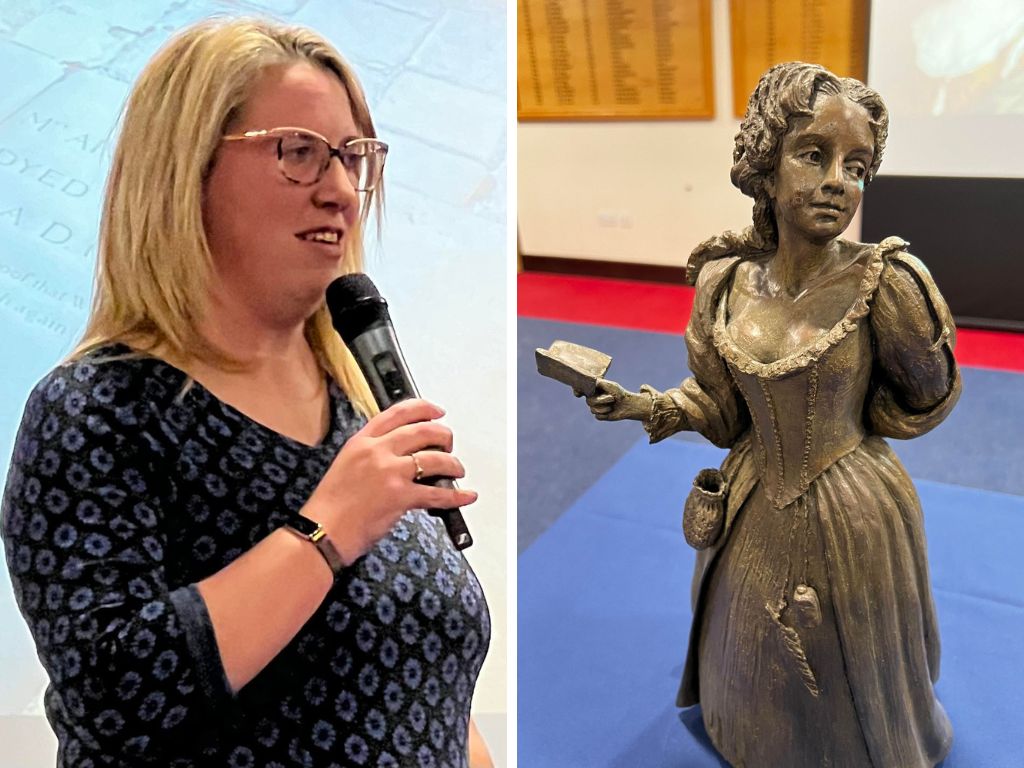
Charlotte spent over a decade working as an English and Drama teacher and was for some time the Head of Sixth Form at King’s School in the city. She is now a local politician and is the Cabinet Member for Heritage, Open Spaces (and bins!) on Canterbury City Council. She is also studying for a PhD based on her research about Aphra – someone that few of us knew much (if anything) about
“Aphra is an icon of the 17th century in my eyes,” said Charlotte – and her enthusiasm for increasing awareness about Aphra certainly came across in her lively talk.
Setting the scene for us with a timeline of the 1600s – a period that included the English Civil War, the execution of Charles I and the outbreak of the Great Plague in London – Charlotte described the 17th century as truly “transformative”.
It was against this backdrop that, in 1640 in the village of Harbledown, a baby girl was born. She was baptised at Harbledown Church as Eaffry Johnson (versions of Aphra – there being no standardised spelling – being a common name back then). Her father came from a relatively poor family from Smeeth – “not a family of connection”. He married Aphra’s mother, Elizabeth Denham, when she was already five months pregnant; such marriages were not unusual in those days. Elizabeth came from a better-connected family – as Charlotte described it, “aristocracy light”.
In those days Canterbury was quite rebellious in its own way: in 1647 it had resisted the “cancellation” of Christmas by anti-royalist Oliver Cromwell. Shops stayed open and people even started to play football in the streets. Incensed by this, Cromwell sent people down to tear down the city gate and walls – that damage is still very much visible today.
Aphra would have been living in the city at the time – her family had moved there from Harbledown in 1643. Aphra’s father had been keen to become a barber – but was stymied by the fact that he wasn’t a guild member; guild membership was required to work within the City walls. He petitioned the Mayor but met with no success. However, around 1647, he was eventually granted freedom of the city as an innkeeper – but for the grand sum of £10, equivalent to a year’s salary at the time. Eventually he borrowed the money and set up as an inn-keeper. Aphra grew up in the City – her family lived near the Poor Priest’s Hospital.
But how did a barber’s daughter who didn’t go to school get to the position she later reached? Charlotte suggested this may have been thanks to Aphra’s mother’s connections. Her mother served as a wet nurse to a well-connected local family to whom she was related. The supposition is that this gave Aphra access to a library. The fact that Aphra could communicate in French would not have been unusual either – at the time it’s thought around a quarter of Canterbury was French speaking because of the large community of Huguenot refugees. Hearing/speaking French not uncommon – especially for those with a trade.
As for other females in that era, Aphra did not go to school – King’s and the few other local schools were only for boys. Years later, when Aphra was about 40, she wrote a poem titled “To Mr Creech on his Excellent Translation of Lucretius” from which it’s clear she was furious that women were not allowed to learn. “Till now I cursed my birth, my education,” she wrote.
While she was growing up at least one of Aphra’s brothers died in the city. Meanwhile, Aphra’s father was imprisoned in Westgate Towers as a debtor – for the £10 debt he owed. At the same time, he had to pay for food and lodgings, which only added to his debt. The poverty-stricken family had no option but to take food from the city basket (the Early Modern equivalent of a food bank).
When Aphra was 17 or 18 years old the family moved to London. Somehow Aphra became a spy in Suriname, then a Dutch Colony in South America. In essence, she was likely recruited by the Killigrew family to spy on William Scott (a distant relative of those Scott’s of Scott’s Hall near Canterbury) – an enemy of Charles II. How and why she was recruited is unclear. She may have been chosen because she was bright, a linguist and had loose connection to Scott’s family. Her mission, it seems, was to get Scott to come back to England following his father’s shame as a regicide, or get information about plans being made by the former supporters of Cromwell, now living abroad.
In Suriname Aphra witnessed the abuse of enslaved people. Twenty-five years later she wrote “Oroonoko”, about an enslaved African Prince, that is viewed by many as the first novel on English. It later became a popular play that was “the Mousetrap of its generation”.
Aphra’s semi-autobiographical play, “The Rover” also became very popular. In it, a Cavalier wants the biggest whore in town (a woman named Angellica Bianca) to fall in love him. She does, but it all ends badly when she threatens to shoot him!
Aphra went on to become the most prolific playwright of the era; her plays remained popular for decades, and she became the first fully professional woman writer in the whole of the English language. (Until then, female authors tended to be nuns, midwives, religious activists or cookery book writers, none of whom would take money from their writing – an action that would have seemed like prostitution in those days). “Without Behn there is no Brontë, there is no Austen…there is no George Elliot,” said Charlotte, emphatically.
Aphra mixed with unusual company – she was friends with Nell Gwynne and Moll Davies. (both mistresses of Charles II and ladies about whom diarist Samuel Pepys also wrote). Aphra even dedicated a play to Nell. At one point Moll went to Aphra for help getting rid of a rival for Charles’ affections. Aphra gave her a concoction that gave the love rival diarrhoea!
Despite her name change from Johnson to Behn, it’s unclear if Aphra was ever married. Not much is known about “Mr Behn”. In fact, it’s possible that Aphra was a lesbian, or at least not too interested in being married, and that Mr Behn didn’t even exist.
Aphra Behn died on the 16th of April 1689. The cause of death seems to vary according to people’s viewpoint about her: either breast cancer for fans or syphilis for those not fond of her. After her death literary fashions changed and the 18th and 19th centuries were less accepting of her works. Victorians simply thought her lewd. As a result, “history covered her up”. It’s only thanks to author Vita Sackville-West and her lover Virginia Woolf that she is now known.
Aphra is buried in Westminster Abbey – near the exit on the way to the gift shop – not Poet’s Corner as one might expect.
Charlotte ended her talk by showing us a model of a statue by Christine Charlesworth, showing Behn at around 17 years of age. The full-sized statue will be erected soon outside The Beaney. It will be one of the very few non-Royal statues of women in the whole of the United Kingdom.
Charlotte’s next big project is to campaign to make Canterbury a UNESCO City of Literature, so that Aphra can stand proudly alongside Marlowe and Chaucer, showcasing the literary heritage of our city.
You can read more about Aphra here.
You can also help support the statue campaign (and the campaign to celebrate other people, buildings and successes of the city) by joining the Canterbury Commemoration Society here.
There will be an exhibition about Aphra Behn in the Beaney Museum this coming summer for 3 months – hopefully everyone will visit. There is also a year-long Aphra Behn series of events taking place across the city, run by Canterbury Christ Church University and other partners, see here.
Picture: Charlotte (left) and the model of a statue of Aphra by Christine Charlesworth (right). Picture credit: Rotary Club of Canterbury.


